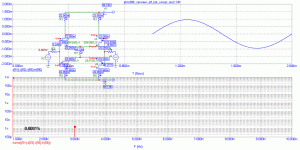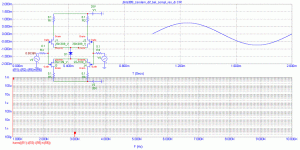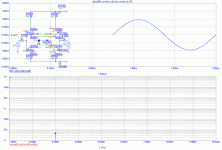PMA, what happens if you replace the 10ma current source with a short? This could be very important.
john curl said:PMA, what happens if you replace the 10ma current source with a short? This could be very important.
My deep admiration, John.
Pavel
Attachments
PMA, it looks a little too amazing! How about changing the Idss to 15 ma, which is more reasonable? Also, a single 10 ohm resistor instead of the short would be interesting.
In case we replaced CCS by short, there was not much means to set Id, only JFET parameters (Vt etc.). I will try resistor, this will definitely set the current.
It depends on Isignal/Id ratio. Also, in case of complementary diff circuit, the 4 devices contribute by their currents, they can operate with smaller amplitude, in more linear part of transfer function. And distortion cancellation, it all leads to very good results, in real circuit depending on parameter and thermal matching of the devices.
Yes, but there should be an interaction between the top and bottom devices, as well. We need a way to control Ids better. Perhaps a small floating Voltage source rather than a resistor or short to get down to 10-15ma. The resistor will change the interaction, so it is problematic.
How do you manage gain (without global negative feedback) and fet input overload in such a configuration 

Ok John 😉
I am trying to find a suitable small floating voltage source (150 mV) maybe a schottky ? 5819 or the like.
I am trying to find a suitable small floating voltage source (150 mV) maybe a schottky ? 5819 or the like.
PMA, if we could have a floating 50mV voltage source in place of the short, we should be near optimum. We might need slightly more voltage, but this would be a good start.
Everyone, PMA's link is now working. It is very interesting to compare the various configurations. Once we get the baseline right, then major changes can be added to see the overall effect. Richard, your input is valuable, but just let us get this baseline nailed down first. The only idealistic limitation that I see at this time is controlling what would normally be controlled by Idss. An added 50-75mV floating voltage source should do that.
Of course, other inputs are welcome.
Of course, other inputs are welcome.
Floating voltage (between upper and lower circuit) - it works, but with higher voltage (1V), and smaller resistor (1 ohm or nothing). It controls Id and keeps low distortion. I will be back in an hour or two.
Now the current is 22mA. It is all a game of JFET threshold voltage, Vdiode (or voltage source).
Also, distortion depends on JFET grade (BL, V, GR). Maybe I could make a comparison and add to a current web page article.
We have pretty nice result with 2 diodes (9.5mA). Resulting dI(outdif)/dV(indif) is 1mA/7mV.
Also, distortion depends on JFET grade (BL, V, GR). Maybe I could make a comparison and add to a current web page article.
We have pretty nice result with 2 diodes (9.5mA). Resulting dI(outdif)/dV(indif) is 1mA/7mV.
Attachments
- Status
- Not open for further replies.
- Home
- Amplifiers
- Solid State
- John Curl's Blowtorch preamplifier



